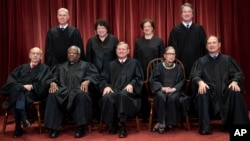The Chief Justice of the United States, John Roberts, said in 2014 that courts will always be careful when it comes to “the next big thing” in technology. And it took a worldwide pandemic for the U.S. Supreme Court to finally agree to use, of all things, the telephone.
In May, the court’s members will hear arguments over the telephone for the first time. Public television service C-SPAN will broadcast audio of the arguments “live.”
Clare Cushman is director of publications at the Supreme Court Historical Society. She called the decision to use telephones a “giant leap forward” for a place that sticks to tradition. But she noted that hearing arguments on the phone is somewhat backward given how much of the country and other courts are now using video conferencing.
Until 1971, the Supreme Court was still using pneumatic tubes to send documents. They were popular in the late 1800s for shipping mail, papers, and other things between offices. The court was still using Linotype machines to print documents in the early 1980s while others printed from desktop computers.
Just two years ago, the high court made its documents available on the internet, well after other courts.
Before the coronavirus crisis, Supreme Court justices were exchanging messages and opinions on paper. Yet most of the nine justices — six of them over the age of 65 — appear to use modern technology in their own lives.
Justice Elena Kagan has said she is on the social media website Twitter. Justice Samuel Alito has described reading legal briefs on an Apple iPad. Justice Sonia Sotomayor wears an electronic sensor that keeps watch over her health. And Justices Neil Gorsuch and Brett Kavanaugh have young children who might be expected to send text messages to their fathers.
This month, 81-year-old Justice Stephen Breyer used the videoconference service Zoom to talk to students at a New York school. Justice Ruth Bader Ginsburg is the oldest member of the court at the age of 87. She reads emails on an iPhone and once told people that she uses another Apple device as a sound machine to help her sleep.
Still, the decision to hear arguments via telephone during six days in May was unimaginable two months ago. The change is an effort to limit large gatherings of people to slow the spread of the disease COVID-19.
This year, the cases before the Supreme Court include President Donald Trump’s effort to keep his tax and financial records secret. The court also will hear whether Electoral College members must vote for the candidate who won their state in presidential elections.
The court’s willingness to use telephones might last only a short time. But those who want more openness on the court hope it will continue after the pandemic.
Melissa Murray is a law professor at the New York University School of Law. She said live audio gives Americans the ability to observe the third branch of the U.S. government at work. She added, “I don’t know why you wouldn’t want that.”
Stephen Dillard serves on the Georgia Court of Appeals. He supports openness in the courts. He told The Associated Press, “This is a great first step, and I’m excited about it, but I hope they will go further in years to come and allow live video streaming.”
I'm Jonathan Evans.
The Associated Press reported this story. Hai Do adapted the story for Learning English. George Grow was the editor.
_______________________________________________________________
Words in This Story
pandemic - n. an occurrence in which a disease spread quickly around the world
brief - n. a document that states the facts a lawyer plans to use in a court case
branch - n. a major part of a government
excited - adj. very enthusiastic and eager about something








